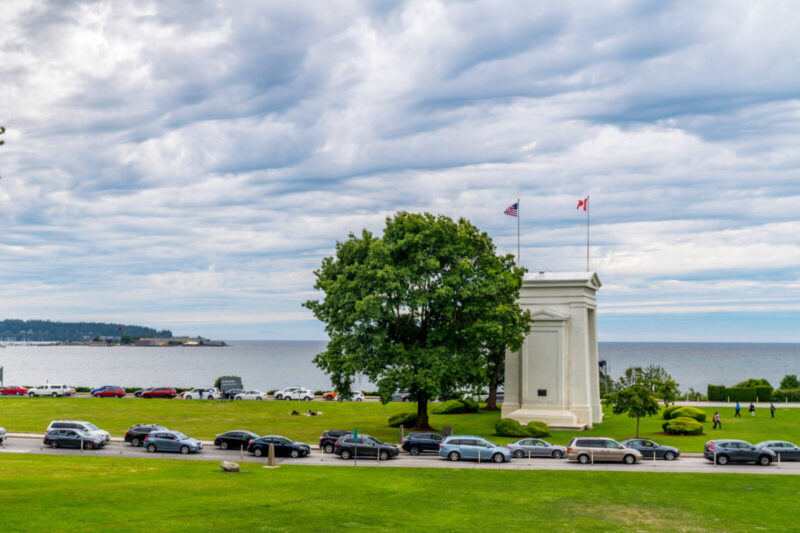By Daniel Schrager, The Bellingham Herald
When you’re a city located just 20 miles from southern Canada like Bellingham is, getting to the border is easy. Crossing can be a little more complicated.
Between picking the right crossing, navigating wait times, and having the proper documentation, there’s a lot to keep in mind when heading up north. Here’s what you need to know to make your trip a lot less complicated.
Documentation to cross Canadian border
U.S. residents don’t need a visa to cross the border, so a valid U.S. passport will get you across just fine. A Certificate of Indian Status is also sufficient documentation. Permanent U.S. residents can bring a Green Card along with a non-U.S. passport. Washington is one of five states to offer enhanced driver’s licenses, which also work for getting across the border.
Parents travelling with a minor who doesn’t have a passport can present the child’s birth certificate instead.
According to Selene Millsap, acting chief at the Lynden-Aldergrove Crossing for the Canadian Border Services Agency, one of the easiest ways to avoid a headache crossing the border is knowing which documents you need and having them ready.
“Not having your travel documents ready when you see the officer is a reason that could add a little bit more time to your crossing,” Millsap said.
NEXUS for pre-screened travel
Another option is NEXUS, a program that allows pre-screened travellers to skip the long lines at the U.S.-Canada border. Members have access to designated lanes at the border and a NEXUS card is acceptable documentation for entering Canada too.
NEXUS is a popular option for travellers, with more than 600,000 active members in the so-called “Cascadia Gateway” between Washington and British Columbia, according to a 2019 report from Western Washington University’s Border Policy Research Institute along with University at Buffalo and the University of Windsor’s Cross Border Institute. The same report found that more than 90 per cent of NEXUS members entering Canada waited less than five minutes at the Peace Arch Crossing in Blaine, Wash., compared to less than 50 per cent of non-members.
You need to apply in advance for NEXUS, and getting an appointment can take time, as can getting approval. You’ll have to undergo a background check and conduct interviews with each of the two countries. According to the DHS, the approval process can take up to 14 months, so make sure to leave plenty of time. Enrolment costs US$50.
While NEXUS is similar to the Global Entry program, a Global Entry card won’t get you access to NEXUS lanes or across the border on the way to Canada. It can be used to access NEXUS lanes on the way back into the U.S.
U.S.-Canada border crossings
If you’re driving across the border, you’ll have your choice of border crossing points. The Peace Arch Crossing, located between Blaine, Wash. and Douglas, B.C., is an easy trip up I-5 and right on the way to Vancouver, B.C. Just east of there is the Pacific Highway Crossing, also in Blaine.
Not driving to Vancouver? The Lynden Crossing is the closest to Bellingham at 20 miles away. It’s a straight shot north on State Route 539.
Located over 10 miles east is the Sumas Crossing.
Wait times at the Canadian border
Waiting in line can double or triple the amount of time spent crossing the border in some cases. Luckily, there are resources to help you minimize the amount of time you spend in line. Both the Washington State Department of Transportation and CBSA keep an updated list of wait times at each border crossing on their websites.
According to Millsap, weekends and Fridays before holidays tend to have the longest waits. Wait times fluctuate during the day, so she recommends checking online to see how long the lines are ahead of your trip.
Tips and tricks for border crossing
Millsap said that people travelling into Canada should be as prepared as possible when they reach the border.
“A lot of the time people come up and they might have limited knowledge about what’s in their car,” Millsap said. “If they do end up getting sent in for examination, they think that they’re declaring their goods properly but they forgot something that’s potentially of interest to us in the vehicle. For a lot of Americans that can be things like firearms that are prohibited and restricted to import into Canada.”
In addition to firearms, Millsap said that cannabis and animals often cause delays at the border.
“It might be legal to possess (cannabis) in both Washington state and British Columbia, but you cannot cross the border with it,” Millsap said. “Another common one that we see here is food, plants or animals that have restrictions. If you’re travelling with a pet or importing an animal, you need specific paperwork or documents for some of those importations.”
Travellers are often afraid to ask questions at the border, but Millsap said that asking questions is the best way to avoid confusion.
“People are obviously nervous when they cross the border so they try avoiding asking questions,” Millsap said. “So I would encourage people to always remember that if you’re not sure, ask the border services officer. Speaking up if you’re not sure is definitely going to help your situation rather than hinder your situation.”
Plan your adventures throughout the West Coast at westcoasttraveller.com and follow us on Facebook and Instagram @thewestcoasttraveller. And for the top West Coast Travel stories of the week delivered right to your inbox, sign up for our weekly Armchair Traveller newsletter!











 Retirement planning: BC Ferries launches concept images for new vessels
Retirement planning: BC Ferries launches concept images for new vessels